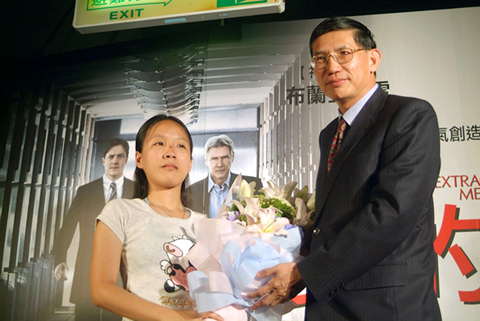The movie Extraordinary Measures tells the story of parents who formed a biotechnology company to develop a drug that could save the lives of children who have the rare life-threatening disease known as Pompe.
In the movie, which is based on the book The Cure, Harrison Ford plays research scientist Robert Stonehill, who was instrumental in finding the cure, while Brendan Fraser plays John Crowley, the man who raised US$100 million to buck the medical establishment.
In reality, John Crowley is the name of the person who started the biomedical company, but the real Dr Stonehill who developed the cure is in fact Chen Yuan-tsong (陳垣崇), director of Academia Sinica’s Institute of Biomedical Sciences.

PHOTO: CNA
At an event held earlier this week by the Taiwan Foundation for Rare Disorders to mark the debut in Taiwan of the movie’s DVD, Chen said he had mixed feelings watching the movie.
He said he began researching a cure for Pompe disease in 1991 after being saddened by the deaths of so many children from the affliction.
“Before I knew it, it had been 15 years,” he said. “It also surprised me that Hollywood would have made a motion picture out of it, making it the second movie about rare diseases and patients after Lorenzo’s Oil.”
Movie critic Roger Ebert said that Harrison Ford, as the film’s executive producer, probably saw Stonehill as a good role for himself and ordered a rewrite of the script because he could not play Chen.
Regardless of how Hollywood decided to recast Chen, his contribution to helping find the cure is well established.
He developed the treatment with colleagues at the Duke University Medical Center. His research and development was mostly done in the US, but Chen conducted his clinical trials for the cure — later named Myozyme — at National Taiwan University Hospital.
Myozyme, which took Chen and his team 15 years to research and develop, was introduced in Taiwan by US pharmaceutical company Genzyme and has been covered by the National Health Insurance (NHI) program since 2005, the foundation said.
Myozyme was sold in Europe and the US after it was approved by the US Food and Drug Administration and the EU health authority in 2006. It has contributed to saving the lives of more than 1,000 patients with Pompe disease, or acid maltase deficiency, worldwide each year, including 34 in Taiwan.
Young Pompe disease sufferers have symptoms similar to muscular dystrophy, the foundation said.
Without a cure, most children with Pompe disease die before they reach two years old. There is also a juvenile and adult form of the disease, which can appear at almost any age, the foundation said.
Currently, Pompe disease patients in Taiwan receive NT$7.9 million (US$245,577) per patient per year in Myozyme and related medical care under the NHI program, greatly reducing their families’ financial burden, the foundation said.
The foundation quoted tallies from the Cabinet-level Department of Health as indicating that there are nearly 6,000 families with rare disease patients in Taiwan, but more than 70 percent of them do not receive effective drugs or therapies, the foundation said.

Taiwan is to commence mass production of the Tien Kung (天弓, “Sky Bow”) III, IV and V missiles by the second quarter of this year if the legislature approves the government’s NT$1.25 trillion (US$39.78 billion) special defense budget, an official said yesterday. Commenting on condition of anonymity, a defense official with knowledge of the matter said that the advanced systems are expected to provide crucial capabilities against ballistic and cruise missiles for the proposed “T-Dome,” an advanced, multi-layered air defense network. The Tien Kung III is an air defense missile with a maximum interception altitude of 35km. The Tien Kung IV and V

The disruption of 941 flights in and out of Taiwan due to China’s large-scale military exercises was no accident, but rather the result of a “quasi-blockade” used to simulate creating the air and sea routes needed for an amphibious landing, a military expert said. The disruptions occurred on Tuesday and lasted about 10 hours as China conducted live-fire drills in the Taiwan Strait. The Civil Aviation Administration (CAA) said the exercises affected 857 international flights and 84 domestic flights, affecting more than 100,000 travelers. Su Tzu-yun (蘇紫雲), a research fellow at the government-sponsored Institute for National Defense and Security Research, said the air

A strong continental cold air mass is to bring pollutants to Taiwan from tomorrow, the Ministry of Environment said today, as it issued an “orange” air quality alert for most of the country. All of Taiwan except for Hualien and Taitung counties is to be under an “orange” air quality alert tomorrow, indicating air quality that is unhealthy for sensitive groups. In China, areas from Shandong to Shanghai have been enveloped in haze since Saturday, the ministry said in a news release. Yesterday, hourly concentrations of PM2.5 in these areas ranged from 65 to 160 micrograms per cubic meter (mg/m³), and pollutants were

Taiwan lacks effective and cost-efficient armaments to intercept rockets, making the planned “T-Dome” interception system necessary, two experts said on Tuesday. The concerns were raised after China’s military fired two waves of rockets during live-fire drills around Taiwan on Tuesday, part of two-day exercises code-named “Justice Mission 2025.” The first wave involved 17 rockets launched at 9am from Pingtan in China’s Fujian Province, according to Lieutenant General Hsieh Jih-sheng (謝日升) of the Office of the Deputy Chief of the General Staff for Intelligence at the Ministry of National Defense. Those rockets landed 70 nautical miles (129.6km) northeast of Keelung without flying over Taiwan,